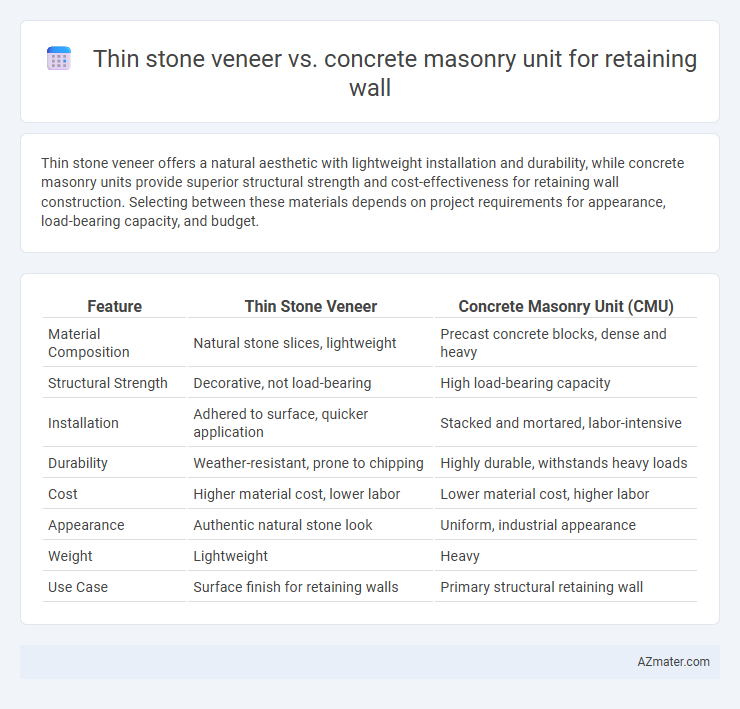Thin stone veneer offers a natural aesthetic with lightweight installation and durability, while concrete masonry units provide superior structural strength and cost-effectiveness for retaining wall construction. Selecting between these materials depends on project requirements for appearance, load-bearing capacity, and budget.
Table of Comparison
| Feature | Thin Stone Veneer | Concrete Masonry Unit (CMU) |
|---|---|---|
| Material Composition | Natural stone slices, lightweight | Precast concrete blocks, dense and heavy |
| Structural Strength | Decorative, not load-bearing | High load-bearing capacity |
| Installation | Adhered to surface, quicker application | Stacked and mortared, labor-intensive |
| Durability | Weather-resistant, prone to chipping | Highly durable, withstands heavy loads |
| Cost | Higher material cost, lower labor | Lower material cost, higher labor |
| Appearance | Authentic natural stone look | Uniform, industrial appearance |
| Weight | Lightweight | Heavy |
| Use Case | Surface finish for retaining walls | Primary structural retaining wall |
Introduction to Retaining Wall Materials
Thin stone veneer provides a natural stone appearance with reduced weight, making it ideal for aesthetic retaining walls that require a decorative finish. Concrete masonry units (CMUs) offer superior structural strength, durability, and cost-effectiveness, commonly used in load-bearing retaining wall applications. Choosing between thin stone veneer and CMU depends on factors like wall height, environmental exposure, and desired visual appeal.
Overview of Thin Stone Veneer
Thin stone veneer offers a lightweight, aesthetically appealing option for retaining walls, mimicking the natural look of full stone without the heavy weight and high cost. It consists of thin slices of natural or manufactured stone adhered to a substrate, providing durability, weather resistance, and easy installation compared to traditional concrete masonry units (CMUs). This veneer enhances the visual appeal while allowing for more design flexibility and faster construction times in landscaping and structural projects.
Overview of Concrete Masonry Unit (CMU)
Concrete Masonry Unit (CMU) is a versatile building block composed of cast concrete, typically measuring 8x8x16 inches, known for its durability and structural strength in retaining wall applications. CMUs offer excellent load-bearing capacity, fire resistance, and ease of installation, making them a preferred choice for long-lasting, stable retaining walls. Unlike thin stone veneer, CMUs provide inherent structural support without the need for additional framing or reinforcement.
Structural Performance Comparison
Thin stone veneer offers aesthetic appeal with limited structural strength, relying primarily on the underlying substrate for load-bearing capacity, whereas concrete masonry units (CMUs) provide robust structural integrity essential for retaining walls due to their high compressive strength and durability. CMUs can withstand significant lateral earth pressures and moisture exposure better than thin stone veneers, which are prone to cracking and detachment under load. For retaining walls demanding reliable load resistance and long-term stability, CMUs are the preferred choice over thin stone veneer.
Aesthetic Differences and Design Options
Thin stone veneer offers a natural, textured appearance with a range of colors and patterns that mimic real stone, enhancing the visual appeal of retaining walls in residential and commercial landscapes. Concrete masonry units (CMUs) provide a more uniform, industrial look but can be customized with various colors, shapes, and finishes such as split-face or stamped designs to broaden aesthetic possibilities. Design options with thin stone veneer prioritize elegance and authenticity, while CMUs emphasize versatility and cost-effective creativity in retaining wall construction.
Installation Process and Labor Requirements
Thin stone veneer offers quicker installation due to its lightweight nature and ease of adherence to existing structures, requiring skilled labor for precise placement and mortar application. Concrete masonry units (CMUs) demand more labor-intensive processes involving block laying, alignment, and mortar joint finishing, often necessitating multiple workers to handle the heavier materials and ensure structural integrity. The installation of thin stone veneer generally reduces overall labor hours and costs compared to the more time-consuming and physically demanding CMU installation.
Durability and Weather Resistance
Thin stone veneer offers superior durability and weather resistance due to its natural stone composition, which withstands freeze-thaw cycles and resists moisture infiltration effectively. Concrete masonry units (CMUs) provide strong structural support but require sealants or coatings to enhance weather resistance and prevent water damage over time. Choosing thin stone veneer for retaining walls ensures long-lasting aesthetics and resilience in harsh weather conditions, while CMUs deliver reliable strength with proper maintenance.
Cost Analysis: Thin Stone Veneer vs CMU
Thin stone veneer typically incurs higher material and labor costs compared to concrete masonry units (CMUs) due to the natural stone's price and the skilled installation required. CMUs offer a more budget-friendly option with lower initial expenses and faster construction times, making them suitable for large-scale retaining walls. Maintenance costs for thin stone veneer may also be higher over time due to potential stone replacement, while CMUs generally require minimal upkeep.
Maintenance and Longevity
Thin stone veneer offers superior aesthetic appeal with relatively low maintenance, requiring occasional cleaning and sealing to preserve its natural look and resist weathering. Concrete masonry units (CMUs) provide exceptional durability and structural strength, often requiring minimal upkeep beyond periodic inspection for cracks and efflorescence removal. Both materials deliver long-lasting retention solutions, but CMUs typically outperform thin stone veneer in terms of longevity due to their robust composition and resistance to environmental stressors.
Environmental Impact and Sustainability
Thin stone veneer offers superior environmental benefits compared to concrete masonry units (CMUs) due to its natural material composition and lower embodied energy. CMUs typically have higher carbon footprints from cement production and energy-intensive manufacturing processes. Utilizing thin stone veneer promotes sustainability by reducing resource consumption and enhancing durability with minimal ecological disturbance.

Infographic: Thin stone veneer vs Concrete masonry unit for Retaining wall
 azmater.com
azmater.com